World Haemophilia Day:

World Haemophilia day is celebrated on 17th April every year, aiming to increase awareness about haemophilia and other inherited bleeding disorders.
- The day is celebrated in the honour of Frank Schnabel, founder of the World Federation of Haemophilia (WHF).
- This year’s (2022) theme is “Access for All: Partnership. Policy. Progress. Engaging your government, integrating inherited bleeding disorders into national policy”.
Haemophilia:
- Haemophilia is a medical condition, mostly inherited, in which the ability of blood to clot is severely reduced, so that even a minor injury can cause severe bleeding.
- Haemophilia is caused by a mutation or change, in one of the genes, that provides instructions for making the clotting factor proteins needed to form a blood clot.
- This change or mutation can prevent the clotting protein from working properly or to be missing altogether. These genes are located on the X chromosome.
- Because of the genetics involved in the way the sex of a child is determined, men are more vulnerable to haemophilia than women.
- It is quite a rare disease, about 1 in 10,000 people are born with it.
- The most common type of Haemophilia is called Haemophilia A.
- This means the person does not have enough clotting factor VIII (factor eight).
- Haemophilia B is less common.
- A person with Haemophilia B does not have enough factor IX (factor nine).
- Haemophilia A, occurs in about 1 in 5,000 births, while Haemophilia B is even rarer at about 1 in about 20,000 births.
- Symptoms:
- Big bruises.
- Bleeding into muscles and joints.
- Spontaneous bleeding (sudden bleeding inside the body for no clear reason).
- Prolonged bleeding after getting a cut, removing a tooth, or having surgery.
- The main treatment for Haemophilia is Replacement Therapy.
- Concentrates of clotting factor VIII (for Haemophilia A) or clotting factor IX (for Haemophilia B) are slowly dripped or injected into a vein. These infusions help replace the clotting factor that is missing or low.




